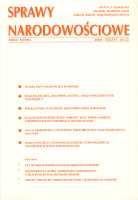Między Rosją i Niemcami. Identyfikacja polityczna i kulturowa Polaków i Czechów
Between Russia and Germany: Political and cultural identification of Poles and Czechs
Author(s): Radosław ZenderowskiSubject(s): Cultural Essay, Political Essay, Societal Essay
Published by: Instytut Slawistyki Polskiej Akademii Nauk
Summary/Abstract: Political and cultural identification of Poles and Czechs (and their countries) remains in strong relation to Germany and Russia. This problem can be seen from two fundamental perspectives. First is a glance at Poles and Czechs from “outside.” Here we find two important questions. Primo, one should analyse changes in Poland and Czechoslovakia after Second World War. Both countries that in the consequence of cold-war political arrangement were forced to the east side of the „iron curtain.” It has influenced policy, demography and territorial status (all these transformations are described in this article). Secundo, one should take into consideration intentions, character and degree of Russia’s and Germany’s influence on Poland and Czechoslovakia. It is interesting to find reasons of shaping attitudes of Poles and Czechs with reference to Russia’s and Germany’s behaviour in international relations. What is the role and political interest of Russia and Germany in Central Europe? The second prospect is to look from “inside” at Russia’s and Germany’s acting on political and cultural identification of Poles and Czechs. Primo, a question appears about defining and expressing national identities by both nations on international level. Political and cultural identity of Poles and Czechs is a subject of research into outer relations (international). We ask about influence of two factors: Russian and German and their consequences on political and cultural behaviour of Poles and Czechs. There are four sociological aspects of this problem. The first important thing is to watch the evolution of social relation to Russia (Russians) and Germany (Germans) by Poles and Czechs since the end of war, particularly after the so called peace revolution (1989). It is a question about a scale of positive and negative feelings to Russians and Germans. The second aspect is identification by Poles and Czechs of typical features of average Russian and German. Third, one should consider at the opinion about relations to Russian and German states on the base of social research made in Poland and the Czech Republic. Fourth, it is interesting to learn what Poles and Czechs, think about their own national identity, about their place and role in Europe in context of close neighbourhood of European and Euro-Asian powers. Secundo, one should put an open question about importance of transnational identification of Poles and Czechs in relation to Central European community.
Journal: Sprawy Narodowościowe
- Issue Year: 2004
- Issue No: 24-25
- Page Range: 133-153
- Page Count: 21
- Language: Polish

